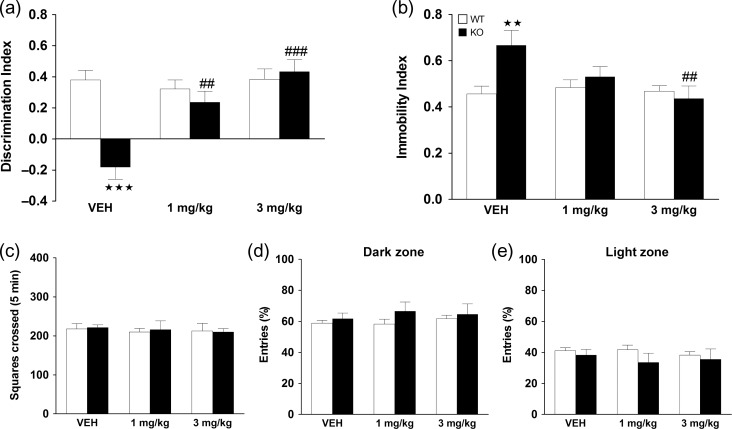Figure 6.
Behavioral assessment following chronic methylphenidate (MPH) treatment. WT and KO mice were treated chronically for 21 days with vehicle, 1 and 3 mg/kg of MPH, and behavioral testing was performed one week after. Long-term recognition memory was assessed in the novel object recognition test in WT (VEH n = 14; 1 mg/kg n = 13 and 3 mg/kg n = 15) and KO (VEH n = 5; 1 mg/kg n = 7 and 3 mg/kg n = 7) mice (a). Depressive-like behavior in the tail suspension test was evaluated by the immobility index in WT (VEH n = 14; 1 mg/kg n = 13 and 3 mg/kg n = 14) and KO (VEH n = 5; 1 mg/kg n = 7 and 3 mg/kg n = 7) mice (b). Values show the mean + SEM. **P < 0.01, ***P < 0.001 versus WT group, ##P < 0.01, ###P < 0.001 versus VEH of same genotype (2-way ANOVA followed by Bonferroni’s post hoc analysis). Locomotor activity was determined by measuring the number of squares crossed in the periphery of the arena in the novel open field in WT mice (VEH n = 14; 1 mg/kg n = 14 and 3 mg/kg n = 16) and in KO (VEH n = 5; 1 mg/kg n = 5 and 3 mg/kg n = 8) mice (c). For anxiety-like behavior, the percentage of entries in the dark (d) and light (e) zones was determined in the light-dark box for WT (VEH n = 12; 1 mg/kg n = 13 and 3 mg/kg n = 14) and KO (VEH n = 5; 1 mg/kg n = 7 and 3 mg/kg n = 7) mice. See Supplementary Table S5 for statistical values.

